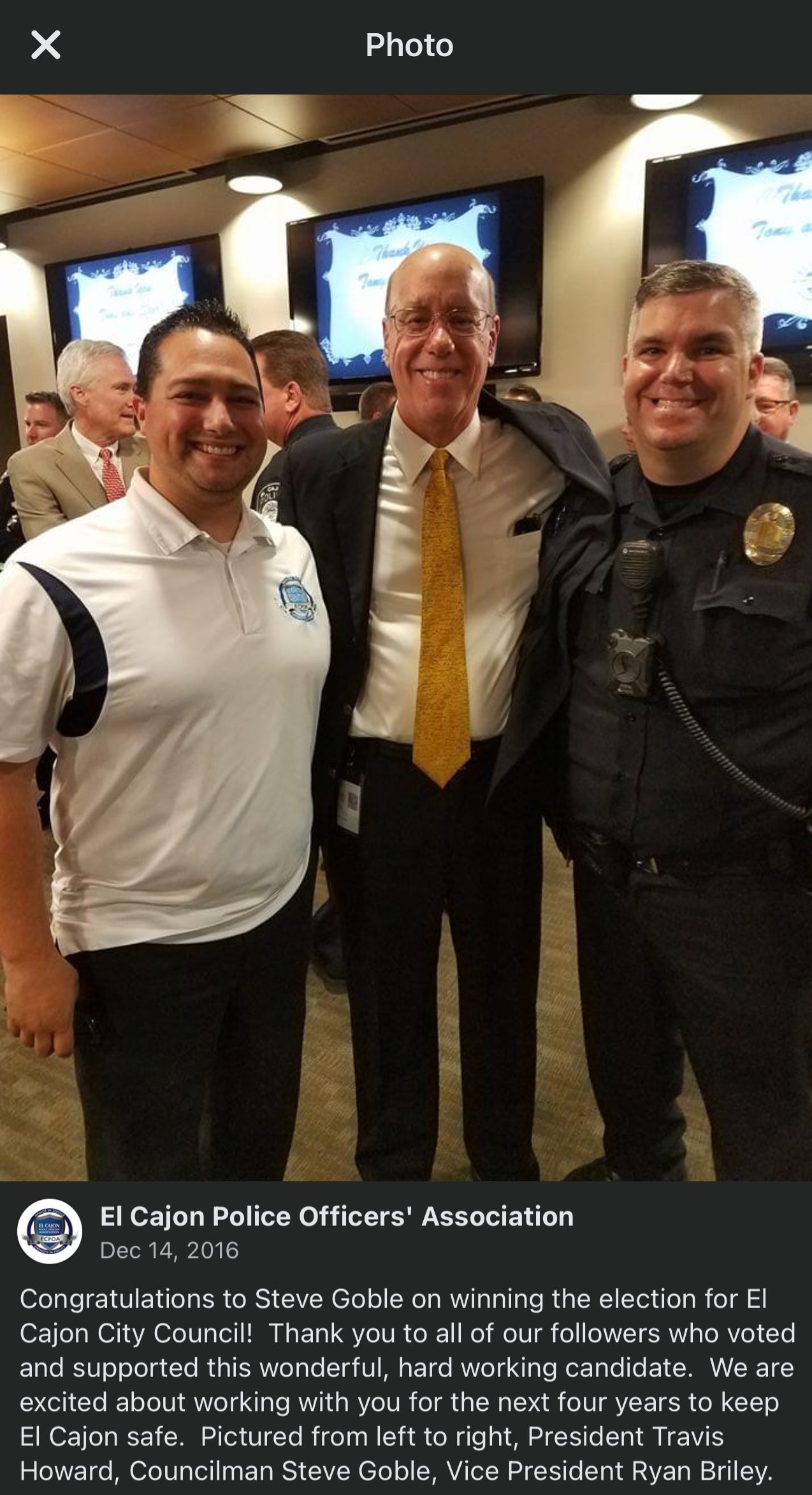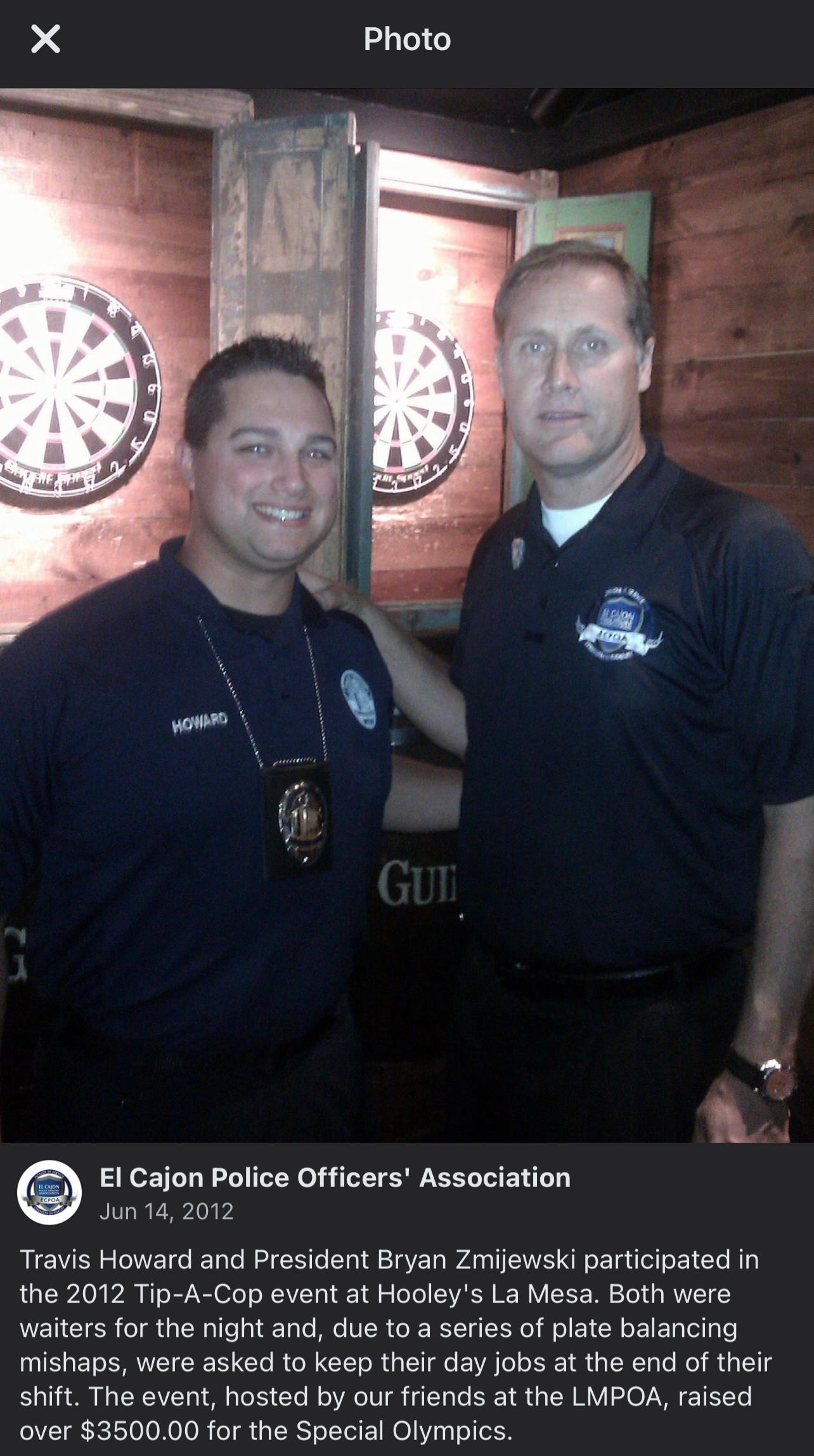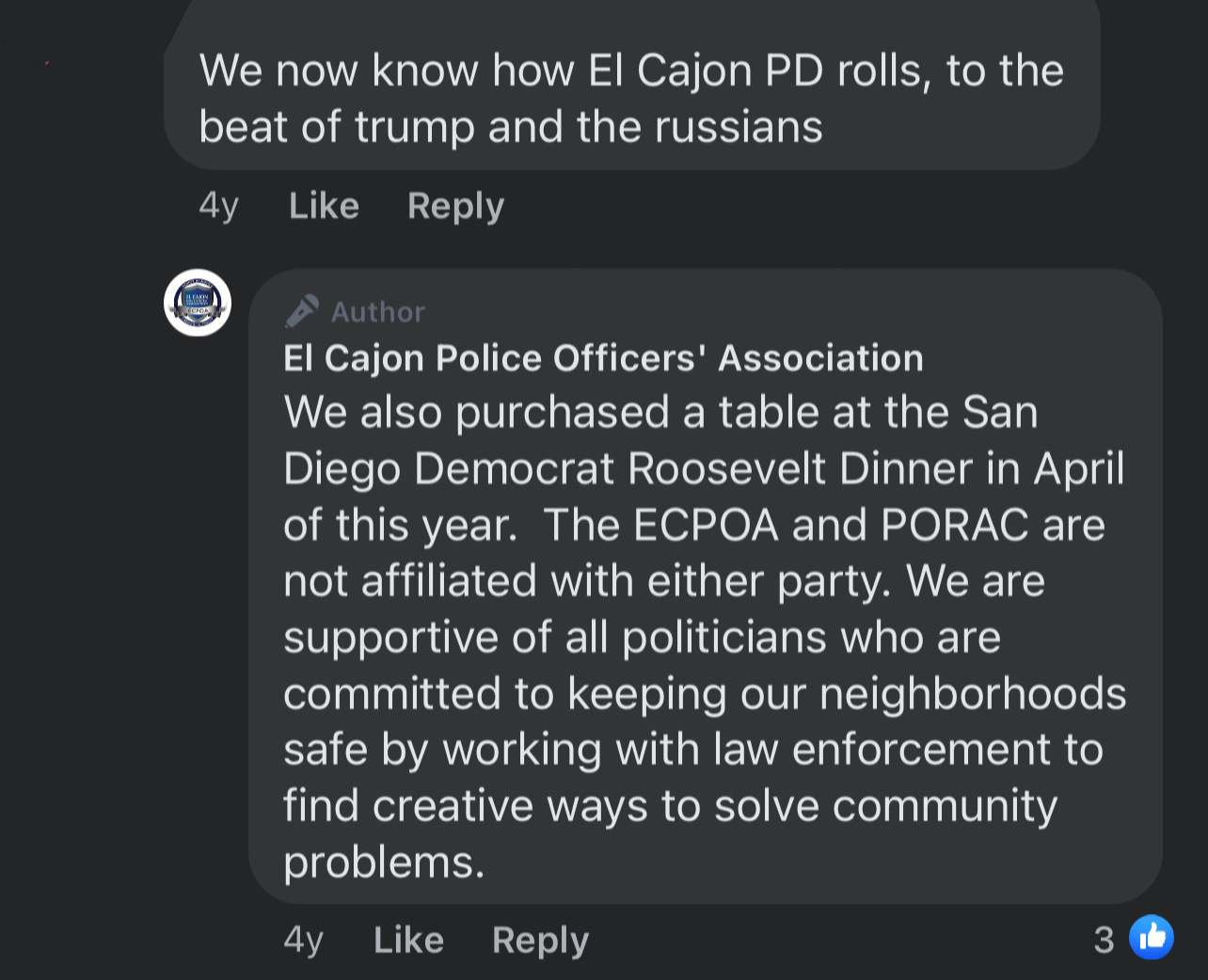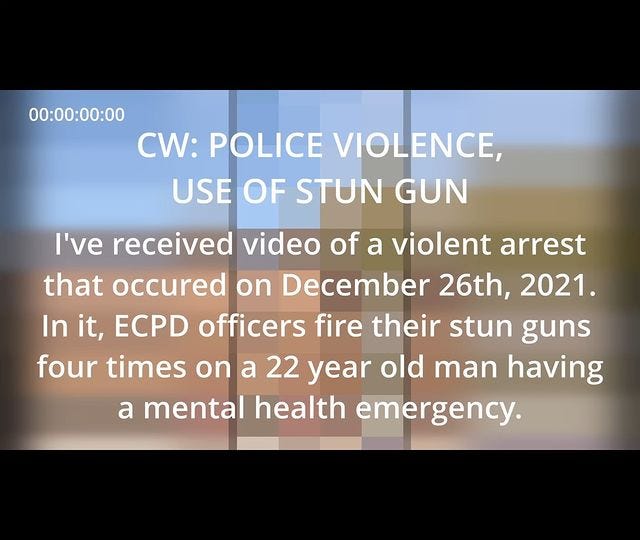ECPD Tases Man During Mental Health Emergency, Police Union Vice President and Board Member On Site
Family member alleges prior harassment.
I was recently contacted by the family member of a twenty-two year old man who was violently arrested in front of his home in El Cajon. The family member, who I’ll refer to as Earl, forwarded me a third party’s footage of the arrest. The video shows officers approaching a young man named Kelvin, before officers discharge their stun guns four times and pile onto him to make the arrest.
In my correspondence with Earl, he told me that he believes this confrontation was racially motivated, as Kelvin is Mexican and visibly tan. Earl told me that officers would sound their sirens to bother Kelvin as he skated around town. Kelvin developed an anxious response to police sirens—Earl says “they make Kelvin freak out.” Earl shares that officers know who his brother is, and that there have been several incidents with police on the street where Kelvin lives that have caused him to feel unsafe. On one occasion, Kelvin went to the police station seeking help, only to be mocked.
“They would giggle and laugh and ask him if he took his meds,” Earl said. “They’re insinuating he is crazy.” Such conduct in response to someone requesting help contradicts the El Cajon Police Department’s stated effort “to maintain a high standard of service and positive relations with the Community.” This treatment provides a deeply troubling context to the footage of Kelvin’s arrest.

The footage is hard to watch. Within the first two minutes of the video, officers discharge their stun guns. at 42 seconds, we hear the characteristic rapid pop of a taser sending current through its darts. The same sound is heard two more times at 48 seconds, and a fourth at 63 seconds. At this point, Kelvin goes rigid, and falls to the ground. Kelvin drops his skateboard as officers move to flatten him out, and at 72 seconds an officer stands by with a police dog between his legs. Over the next few minutes, five officers attempt to restrain Kelvin. Five additional officers stand immediately behind the dog-pile, and others float around the scene. By four minutes and thirty seconds, an officer has retrieved a restraint device that wraps around Kelvin. At 4 minutes and 52 seconds, Kelvin screams desperately for help. Shortly thereafter, Sergeant Howard approaches the cameraperson to begin a dialogue. Notably, Sergeant Howard can be seen in frame aiming a stun gun at Kelvin. It is unclear if he fired. I’ve circled the Sergeant insignia.

The cameraperson asks Sergeant Howard why so many officers are involved in this arrest. Howard replies that Kelvin had a skateboard. The cameraperson asks Howard if he’s going to try to kill a citizen. Sergeant Howard replies: “Kill him? We used a taser.” The cameraperson retorts that Kelvin was tased four times—and that this could have lead to a heart attack. USA Today cites the Fatal Encounters database on this matter, counting “at least 513 cases in which subjects died soon after police used Tasers on them” since 2010. Two other police officers approach: Officer Hasty and Sergeant Michael.

At this point, we are six minutes and twelve seconds into the video. Sergeant Howard says “we didn’t shoot him, we didn’t use our guns.” He goes on to say that Kelvin is perfectly fine: “He’s perfectly fine—as you can hear.” Kelvin is not yelling at this point in the video, but two minutes prior he was screaming and pleading for help.
The cameraperson, seeing that the fire department has arrived, states that Kelvin will now have to go the hospital. Howard states that it’s up to the fire department to decide. He goes on, “we’re putting him in the maximum restraint to keep him from hurting anybody and it’s just more comfortable for him to be in... that way we don’t have to all be on top of him.”

The cameraperson asks Sergeant Howard why so many officers are out for this arrest. Howard replies, “because he was challenging a police officer . . . were you not out here for that?” The cameraperson states that they had seen all of it, and recorded it. Sergeant Howard offers to put the cameraperson’s footage in their case file. The cameraperson states that they only want to help Kelvin, and Sergeant Howard replies that the cameraperson can email their footage to the police. The cameraperson states that they will only talk directly to Kelvin, citing distrust of the police and the institution’s history of violence against marginalized groups.
In reply, at eight minutes and ten seconds, Sergeant Howard states: “well, he’s gonna go to jail, so I don’t know how much you’re going to talk to him.” Meanwhile, officers carry Kelvin to a police cruiser a few feet in front of the camera. Kelvin attempts to speak to bystanders. There is audible distress in his voice as he says the police have been attempting to perform mind control on him, only seconds after Sergeant Howard flippantly remarked that Kelvin would be going to jail. At eight minutes and fifty seconds, Kelvin tells bystanders that these cops are corrupt.

For the next two minutes, officers get Kelvin situated in the back of a police cruiser. By this point there are six total police cruisers in frame at any given time. The cameraperson approaches the family of Kelvin as Sergeant Howard and Sergeant Michael speak to the family. The cameraperson tries to tell the family what they’d seen. Kelvin’s mother is audibly shocked and frightened when the cameraperson tells her that police tased her son four times.
Earl believes that if people need help from the police, then the police need to help them. Earl told me that we pay taxes for police to help us, not to abuse their power. He tells me he wants them to be evaluated by an outside agency, independent from the police—”I don’t want to have the police look into themselves.”
Earl goes on: “I want them to have professional people with them who can help if someone’s having a mental break down.” He told me that people in those circumstances would only feel more fear if they’re met by police, and that someone like that would understandably begin to think of protecting themselves when police are pointing guns at them.
Earl tells me that Kelvin, like many of us, is upset by the state of policing in this country. Earl tells me that he, like many of us, is at times uneasy at the sight of police. “Our family doesn’t come from gangs nor drugs. We mind our business and do our best to do things the right way.”
Kelvin was arrested and charged with Resisting an Executive Officer—a felony—as well as a misdemeanor count of Resisting Arrest. These charges make little sense for someone having a mental health crisis, and even less sense for someone the police know. At twelve minutes and five seconds, Sergeant Michael tells Kelvin’s family that “we’re trying to help him,” but that Kelvin didn’t want to cooperate. The audio is unclear at times, but Sergeant Michael characterizes Kelvin as mentally unwell: “He’s very not all there in his [mental state],” he said, gesturing at his own head. Sergeant Michael tells the family that Kelvin grabbed his skateboard, but the exact action he attempted to describe is unclear. However, it is clear that the Sergeant is attempting to justify the use of force.

“He was alone, and that probably frightened him even more,” Earl told me. “Kelvin tells me about his plans for life. All he wants to do is make food for people in need and build community gardens.”
Sergeant Travis Howard is the current Vice President of the El Cajon Police Officers’ Association. He was quoted in a 2016 Wall Street Journal article on the shooting of Alfred Olango, whose death sparked outrage and protests. Sergeant Howard is quoted as the president of the union, and is apparently speaking in that capacity. “After viewing the video, I feel that any reasonable person would have perceived the actions of Mr. Olango as a deadly threat,” he said. Dan Gilleon, an attorney for Alfred Olango’s family also provided comment for the article: “It shows a cowboy with his gun drawn provoking a mentally disturbed person into reacting like a mentally disturbed person.”
Sergeant Howard is seen in several photos on the El Cajon Police Offcers’ Association Facebook page. In 2012, he and then President Bryan Zmijewski raised $3,500 for the Special Olympics at a Tip-A-Cop event. In 2016, he appeared in an El Cajon Police Officers’ Association polo-shirt next to El Cajon city council member Steve Goble, who was endorsed by the police union. Among the achievements listed on Goble’s website are: “April 20, 2020 - Delivered masks to El Cajon Police Department,” “May 3, 2019 - El Cajon Police Department Awards Dinner,” and “October 15, 2018 - Meeting w/ El Cajon Police Officers Association Board Members.” Sergeant Howard was also pictured speaking at a memorial for fallen law enforcement officers, and raising money to get a teenager a new bike lock following a bike theft.
Amid what smacks of public relations content is another appearance by Sergeant Howard in a political context: in 2017 Sergeant Howard attended the San Diego Republican Party Lincoln Reagan Dinner on behalf of the police union. He is pictured wearing a badge that identifies the police union as a Platinum Sponsor. The 2017 prices are not archived, but the 2021 list prices the Platinum Sponsor package at $15,000 per table.
One commenter wrote: “We now know how El Cajon PD rolls, to the beat of trump and the Russians.” The police union’s page responded: “We also purchased a table at the San Diego Democrat Roosevelt Dinner in April of this year. The ECPOA and PORAC are not affiliated with either party. We are supportive of all politicians who are committed to keeping our neighborhoods safe by working with law enforcement to find creative ways to solve community problems.“
Writing for The New Yorker in 2020, Steven Greenhouse cited The University of Oxford and the University of Chicago on police unions’ relationship with public safety: “A 2018 University of Oxford study of the hundred largest American cities found that the extent of protections in police contracts was directly and positively correlated with police violence and other abuses against citizens. A 2019 University of Chicago study found that extending collective-bargaining rights to Florida sheriffs’ deputies led to a forty per cent statewide increase in cases of violent misconduct—translating to nearly twelve additional such incidents annually.”
The El Cajon Police Officers’ Association website gives the union’s supposed raison d'etre: “As an employee union, our priorities are focused on protecting the pay, benefits and working conditions of our membership while helping out our community through donations, sponsorships and charitable events.” The links page displays a photo of three officers, one of whom was present at the arrest of Kelvin. Sergeant Louie Michael is listed as a board member in addition to being pictured on the link page.
The Sergeant is “known in the community as an active ally through his community outreach with the department,” according to 10News. Regrettably, the article I pulled that quote from is titled El Cajon police officer arrested following abusive claims. A video embedded in the article details a restraining order filed in July of 2021. The document cites abuse in which the officer pushes the victim to the floor, hard enough to leave the victim with a sore chest and a head a neck that “feel as though I was whiplashed.” The victims hands and wrists were sore from breaking their fall. Further, the abuse is described as prolonged and characterized by intimidation and manipulation. The San Diego County Sheriff’s department lists a restraining order filed against one Louie Michael on November 4th, 2021. The Domestic Violence Temporary Restraining Order expires later this month.
That two Sergeants associated with the El Cajon Police Officers’ Association were briefing Kelvin’s family on the arrest without disclosing their status as POA Vice President and Board Member gives undue advantage and protection to the department. That these same Sergeants approached the cameraperson to enter their description of the arrest into that footage is even more troubling. According to CalSalaries, Travis Howard was paid $242,350 in 2019, and Louie Michael was paid $228,836 in that same year.
The El Cajon Police Department has not promptly responded to my request for comment. I have filed a public records request for relevant materials.
Update: The uncut footage has finished uploading. You can view it here:













